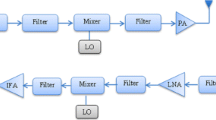Abstract
Energy saving is one of the most important issues of wireless sensor networks (WSNs) that are gaining a lot of attention. In other words, energy modeling plays a greater role in energy optimization that helps designers to produce an economical and practical design of sensor nodes. In this paper, the issue of energy-efficient WSNs design is investigated by focusing on the setting of physical layer parameters. This is achieved by deriving an energy consumption model that considers most of the parameters of the physical layers. The proposed model is validated with real measurements to measure the accuracy of the proposed model. Results show good agreement between proposed model and experimental measurements with mean absolute percentage error less than 6%. The validated model is used to optimize transmitted power and modulation level to achieve minimum energy consumption. Finally, closed-form expressions for optimum transmitted power and modulation level are derived for different modulation schemes.












Similar content being viewed by others
References
Akyildiz, I. F., Su, W., Sankarasubramaniam, Y., & Cayirci, E. (2002). Wireless sensor networks: A survey. Computer Networks, 38, 393–422.
Ammer, J., & Rabaey, J. (2006). The energy-per-useful-bit metric for evaluating and optimizing sensor network physical layers. In Proceedings of the IWWAN06, pp. 1–6.
Wang, Q., Hempstead, M., & Yang, W. A (2006). Realistic power consumption model for wireless sensor network devices. In 3rd Annual IEEE communications society on sensor and ad hoc communications and networks (SECON), pp. 286–295.
He, S., Chen, J., Member, S., Yau, D. K. Y., & Sun, Y. (2012). Cross-layer optimization of correlated data gathering in wireless sensor networks. IEEE Transactions on Mobile Computing, 11, 1678–1691.
Gu, Y., Society, I. C., & Ji, Y. (2013). ESWC: Efficient scheduling for the mobile sink in wireless sensor networks with delay constraint. IEEE Transactions on Parallel and Distributed Systems, 24, 1310–1320.
Melodia, T., Member, S., & Pompili, D. (2007). Communication and coordination in wireless sensor and actor networks. IEEE Transactions on Mobile Computing, 6, 1116–1129.
Tudose, D., Gheorghe, L., & Tpu, N. (2013). Radio transceiver consumption modeling for multi-hop wireless sensor networks. UPB Scientific Bulletin, Series C: Electrical Engineering, 75, 17–26.
Howitt, I., & Wang, J. (2004). Energy efficient power control policies for the low rate WPAN. In Proceedings of the first annual IEEE communications society conference, pp. 527–536.
Wang, T., Heinzelman, W., & Seyedi, A. (2008). Minimization of transceiver energy consumption in wireless sensor networks with AWGN channels. In 46th Annual Allerton conference on communication, control, and computing, pp. 62–66.
Holland, M., Wang, T., Tavli, B., Seyedi, A., & Heinzelman, W. (2011). Optimizing physical layer parameters for wireless sensor networks Curriculum Vitae. ACM Transactions on Sensor Networks, 7, 28.
Amin, O., Bavarian, S., & Lampe, L. (2012). Cooperative techniques for energy-efficient wireless communications, in green radio communication networks. Cambridge: Cambridge university press.
El Kouche, A., Rashwan, A. M., & Hassanei, H. (2013). Energy consumption measurements and reduction of Zigbee based wireless sensor networks. In Ad hoc and sensor networking symposium, pp. 557–562.
Casilari, E., Cano-García, J. M., & Campos-Garrido, G. (2010). Modeling of current consumption in 802.15. 4/ZigBee sensor motes. Sensors, 10, 5443–5468.
Instruments, T. (2011). Measuring the power consumption on CC2530ZNP using CC2530 ZNP mini kit. Application Note AN, 108, 1–22.
Moschitta, A., & Neri, I. (2014). Power consumption assessment in wireless sensor networks. In ICT-energy-concepts towards zero-power information and communication technology, pp. 203–224.
Semiconductor, N. (2007). nRF24L01 Single Chip 2 . 4GHz Transceiver Product Specification v2.0.
Instruments, T. (2007). TMS320F28335, TMS320F28334, TMS320F28332, TMS320F28235, TMS320F28234, TMS320F28232. Digital Signal Controllers (DSCs), Data Manual, Lit. Number SPRS439I, pp. 1–199.
Goldsmith, A. (2004). Wireless communications. Cambridge: Cambridge University Press.
Corless, R. M., Gonnet, G. H., Hare, D. E. G., Jeffrey, D. J., & Knuth, D. E. (1996). On the LambertW function. Advances in Computational Mathematics, 5, 329–359.
Barry, D. A., Parlange, J.-Y., Li, L., Prommer, H., Cunningham, C. J., & Stagnitti, F. (2000). Analytical approximations for real values of the Lambert W-function. Mathematics and Computers in Simulation, 53, 95–103.
Simon, M., & Alouini, M. (2005). Digital communication over fading channels. Hoboken, NJ: Wiley.
Author information
Authors and Affiliations
Corresponding author
Rights and permissions
About this article
Cite this article
Abo-Zahhad, M., Farrag, M. & Ali, A. Optimization of Transmitted Power and Modulation Level for Minimizing Energy Consumption in Wireless Sensor Networks. Wireless Pers Commun 96, 4047–4062 (2017). https://doi.org/10.1007/s11277-017-4367-0
Published:
Issue Date:
DOI: https://doi.org/10.1007/s11277-017-4367-0




